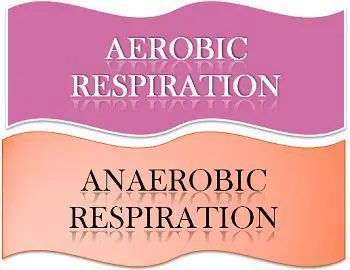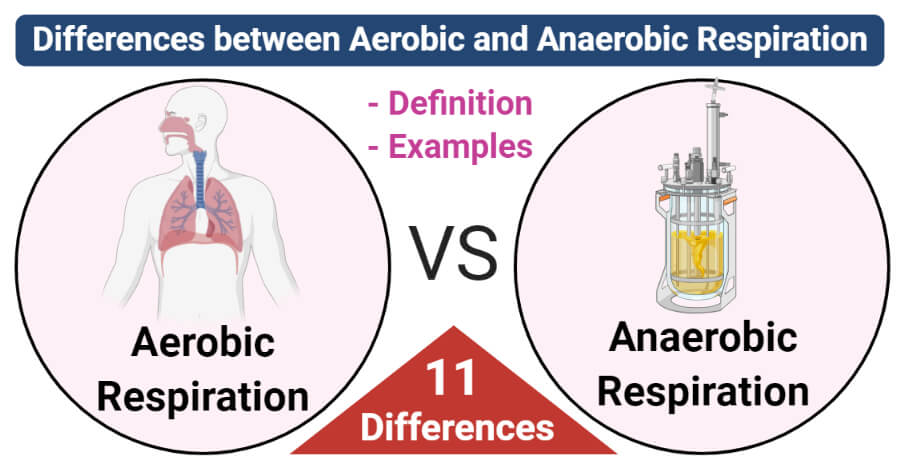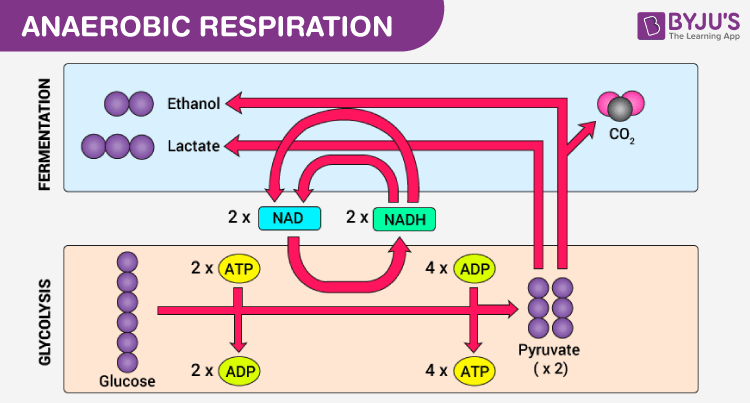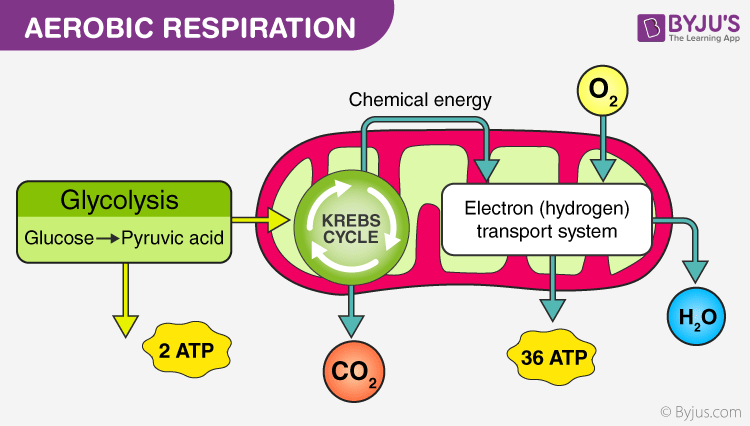Explain How Aerobic and Anaerobic Respiration Is Alike Yet Different
It can be observed in all types of eukaryotic cells. The by-product of this process produces carbon dioxide along with ATP the energy currency of the cells.

Difference Between Aerobic And Anaerobic Respiration Characteristics Process Comparison Anaerobic Respiration Basic Anatomy And Physiology Study Biology
The fundamental difference between aerobic and anaerobic respiration is the usage of oxygen in the process of cellular respiration.

. Aerobic respiration releases 19 times more energy than anaerobic respiration from the same amount of glucose. In addition the reactants for aerobic respiration is both oxygen and glucose yet for anaerobic the reactant is just glucose. The similarity between aerobic and anaerobic respiration is that both break down the food to release carbon dioxide and energy.
Aerobic and anaerobic respiration both have a few similarities and differences. The two types of exercise also have differences when it comes to benefits. Many of the steps in the aerobic and anaerobic cellular respiration.
1 Carbon dioxide and water are the end products of aerobic respiration while alcohol or lactic acid is the end product of anaerobic respiration. Aerobic exercises require oxygen for fuel. The reason for believing that the two processes fermentation and anaerobic respiration are.
In aerobic training it comes from oxygen and energy stored in carbs proteins and fats. The breakdown of glucose in the presence of oxygen to produce more amount of energy is called as aerobic respiration. Compare aerobic respiration anaerobic respiration and fermentation.
The first one is aerobic respiration while the other one is anaerobic respiration. It does not require mitochondria and is completed in cytoplasm ie all enzymes of anaerobic respiration are present in cytoplasm. Cellular respiration is a process that takes place inside the cells where the breakdown of glucose molecules releases energy.
Explain what amphibolic means. By definition aerobic means with oxygen and anaerobic means without oxygen. They cause you to breathe faster and more deeply maximizing the amount of oxygen you can take in.
Aerobic respiration uses oxygen. The end products are water carbon dioxide and energy. This lab Lab-Exploring Anaerobic--attached gives students the basic outline of an experiment.
There is a build-up of lactic acid in the muscles during vigorous exercise. What are the similarities between aerobic and anaerobic respiration Class 7. It produces a by product of energy carbon dioxide and lactic acid.
Aerobic Respiration is the process in which the use of air or oxygen in particular. When there is not enough oxygen for example when you are running hard at the end of a 5k this is called anaerobic respiration. In this step of the module students will discover and explore alternative methods to aerobic cellular respiration.
Compare and contrast cellular respiration and photosynthesis- two similar yet different processes. Food is broken down in the presence of oxygen. Both aerobic and anaerobic respiration involves a first stage called glycolysis.
1 They both use glucose as the starting molecule. The respiration can be aerobic which uses glucose and oxygen or anaerobic which uses only glucose. The process of respiration has two main types.
2 Food is oxidized in both cases and energy is released. Anaerobic respiration occurs mostly in prokaryotes. Lets see 5 similarities between Aerobic and Anaerobic.
The reaction site in the cell for aerobic is in the cytoplasm or mitochondria and just in the cytoplasm for anaerobic respiration. Aerobic respiration is the process of breaking down glucose using oxygen. How do these processes determine which environment the organism can live in.
An aerobic pathway consisting of glycolysis the Krebs cycle and the electron transport chain Glycolysis is the first stage of cellular respiration and is an anaerobic process. Anaerobic exercises do not rely on oxygen for fuel and do not last as long. Anaerobic respiration is respiration without oxygen.
Anaerobic Respiration is the process of breaking down glucose without using oxygen but rather catalysts. The cells use glucose and oxygen to produce carbon dioxide water and energy. How are they different.
All organisms respire in order to release energy to fuel their living processes. During glycolysis glucose is converted to two molecules of pyruvic acid. Glucose is not completely broken down so much less energy is released than during aerobic respiration.
Aerobic respiration as the name suggests is the process of producing the energy required by cells using oxygen. Whereas the breakdown of glucose in the absence of oxygen to produce energy is called as anaerobic respiration. The lactic acid needs to be oxidised to carbon dioxide and water later.
This process takes place in the absence of oxygen and can generally be observed in human muscles cells prokaryotes and methanogens. Aerobic exercise energy in anaerobic training comes from muscles. Anaerobic respiration in muscles.
Explain how this allows the respiration process to be used for carbohydrate lipid and protein biosynthesis. Glycolysis is anaerobic but the Krebs Cycle and ETC are aerobic. Students will be introduced to yeast and investigate the anaerobic respiration process and real world applications.
Image will be uploaded soon Anaerobic Respiration. How they use oxygen. When the body has an adequate supply of oxygen for this process we call it aerobic respiration.
Based on the oxygen usage the process can be conveniently divided into two categories namely aerobic and anaerobic respiration. When observing anaerobic vs. In anaerobic respiration fermentation the carbon-skeleton of glucose molecule is never completely released as CO 2 and in some it may not appear at all.
How are the processes similar. Cells that use it. The process uses a respiratory electron transport chain but does not use oxygen as the electron acceptors.
An aerobic process requires oxygen but an anaerobic process does not require oxygen. Aerobic respiration occurs in most cells. Compare aerobic respiration anaerobic respiration and fermentation.
Following are the substantial differences between both kind of respiration. This process takes place in the presence of oxygen to produce energy. Each of these have difference effects on the body.

Difference Between Aerobic And Anaerobic Respiration With Comparison Chart Bio Differences

Cellular Respiration And Photosynthesis Venn Diagram Cellular Respiration Venn Diagram Photosynthesis And Cellular Respiration

Difference Between Aerobic And Anaerobic Respiration In Simple Language
Examples Of Aerobic And Anaerobic Respiration Aulad Org

Aerobic Anaerobic Similarities Differences Flashcards Quizlet

Difference Between Aerobic And Anaerobic Respiration With Comparison Chart Bio Differences

Similarities Difference Between Aerobic And Anaerobic Respiration

Difference Between Aerobic And Anaerobic Respiration With Table Anaerobic Respiration Aerobics Cellular Respiration

Similarities And Differences Between Aerobic And Anaerobic Respiration Q A
Difference Between Fermentation And Anaerobic Respiration Definition Process Application

Aerobic And Anaerobic Respiration Nice Big Picture Diagram Anna Totten Totten B Remind Anaerobic Respiration Medical Laboratory Science Student Biochemistry

Anaerobic Bacterial Metabolism Process Examples Video Lesson Transcript Study Com

Aerobic Vs Anaerobic Respiration Definition 11 Differences Examples
Differences Between Aerobic Vs Anaerobic Respiration Video Lesson Transcript Study Com
Examples Of Aerobic And Anaerobic Respiration Aulad Org

A Compare And Contrast Aerobic Respiration And Anerobic Respirationo Brainly Ph

Aerobic And Anaerobic Respiration Major Differences

Aerobic And Anaerobic Respiration Major Differences

Aerobic Anaerobic Similarities Differences Flashcards Quizlet